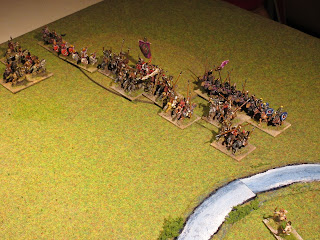Continuing the historical series, the Later Imperial
Rome make use of the eastern order of battle. The number of cavalry and
legionnaires have been increased and among the auxilia there are now sagittarii
(4Bw) present.
The first conflict takes place north of the Danube
which allows the Sarmatians to fight in 'homeland' territory of the steppes. This may pose a problem for Rome as the terrain will be devoid of features to use in deploying troops.
Game 1
Rome on the offensive, caught the Sarmatian scrambling out of their village to reach open ground. As Rome advanced only half the Sarmatian cavalry could deploy to the far bank.
Taking advantage of the situation, the magister militum launched his cavalry against the Sarmatians exiting the village
and placed the auxilia in a position to delay those Sarmatians
crossing the river downstream.
Lacking room to manoeuvre, the Sarmatians took heavy
casualties (two elements) as the clibanarii and equites fell on them in front
and both flanks.
Rome also suffered casualties, but the losses on the
Sarmatian were significant enough to send them fleeing. Score 4 – 2 for the LIR.
Game 2
In the second battle, the Sarmatian have called on the Alani (allies) to defeat the Roman invader; these are deployed on the wings. Rome having the advantage of
ground would be content to hold it.
Seeing the main effort was directed toward the centre,
the Magister Militum moved his left wing to bring the sagittarii into effective bow range. On the right, the equites and skirmishers could deal with the Alani
while the clibanarii and auxilia in centre, moved forward to meet the
Sarmatians on the slope of a gentle hill.
In centre, the Sarmatians unleashed a fury at the
Romans holding the hill and in two successive bounds their chieftain destroyed
half the clibanarii. Other Sarmatian cavalry in support of their general were
less than successful as they were sent back to the base of the hill. On the Sarmatian left,
the Alani made up for their poor performance and destroyed a unit of light
horse.
The final act came when the Sarmatian chieftain signalled
his Alani and Sarmatians to finish the Romans off, then doubling back he sought out the Roman general. The last onslaught delivered the fatal blow leaving the legion and the magister militum littering the battlefield. Score 7g – 2 for
the Sarmatian.
Game 3
The final battle found both armies constrained by the
limited open ground and so both deployments were just under 800 paces.
Rome remained steadfast on their hill position
offering the Sarmatians ample time to coordinate their assault.
Noticing how easily Roman skirmishers had crossed the
river (paltry), the Sarmatian chieftain dispatched light troops of his own to
deal with them. Meanwhile, the Sarmatians and Alani struck the Roman line.
Sarmatian lances found their mark destroying the
legion and its supporting auxilia leaving the Magister Militum dangerously exposed.
Elsewhere, the Alani and the Sarmatian cavalry were being repulsed and losing
ground but both sides experienced heavy casualties (3 – 3).
Following their orders, the auxilia ignored the ‘rally’
signal from their general and fell on the Alani destroying more than half their
number. Seeing the Alani essential destroyed
and his Sarmatian cavalry repulsed elsewhere, the Sarmatian chieftain called
for a retreat. Score 5 – 3 for the LIR.
II/26 Sarmatian
310 BC – 375 AD Terrain type: Steppe,
Aggression 3
1 x general (3Kn), 7 x noble cavalry (3Kn), 1 x scouts
(LH) or noble cavalry (3Kn), 3 x archers (Ps) or noble cavalry (3Kn) or levied
farmers (7Hd).

























































